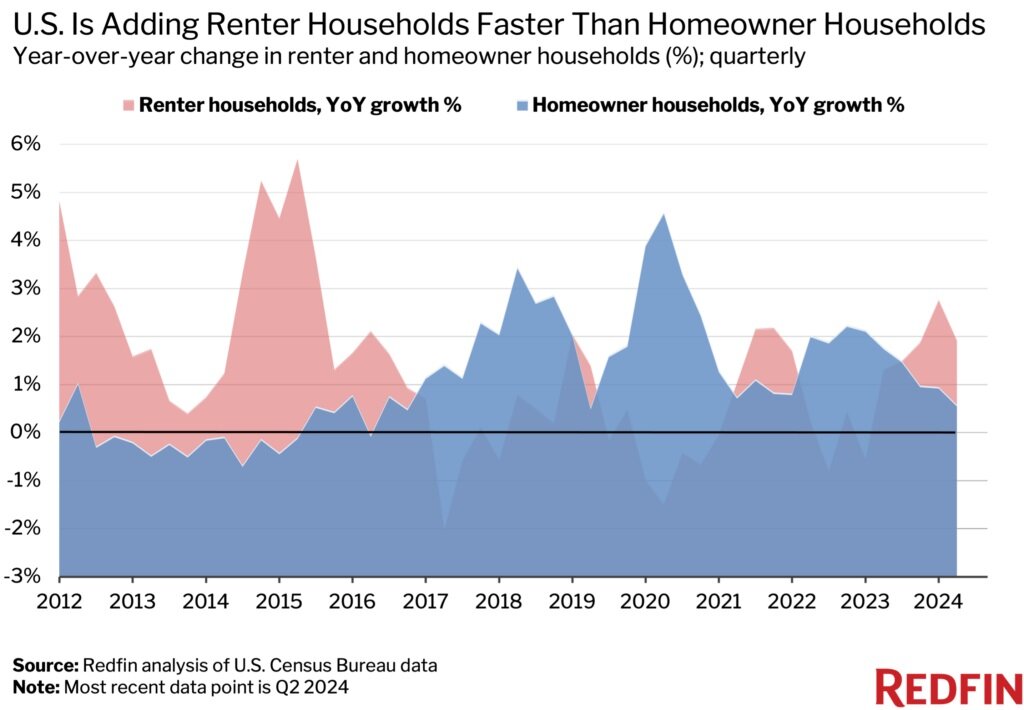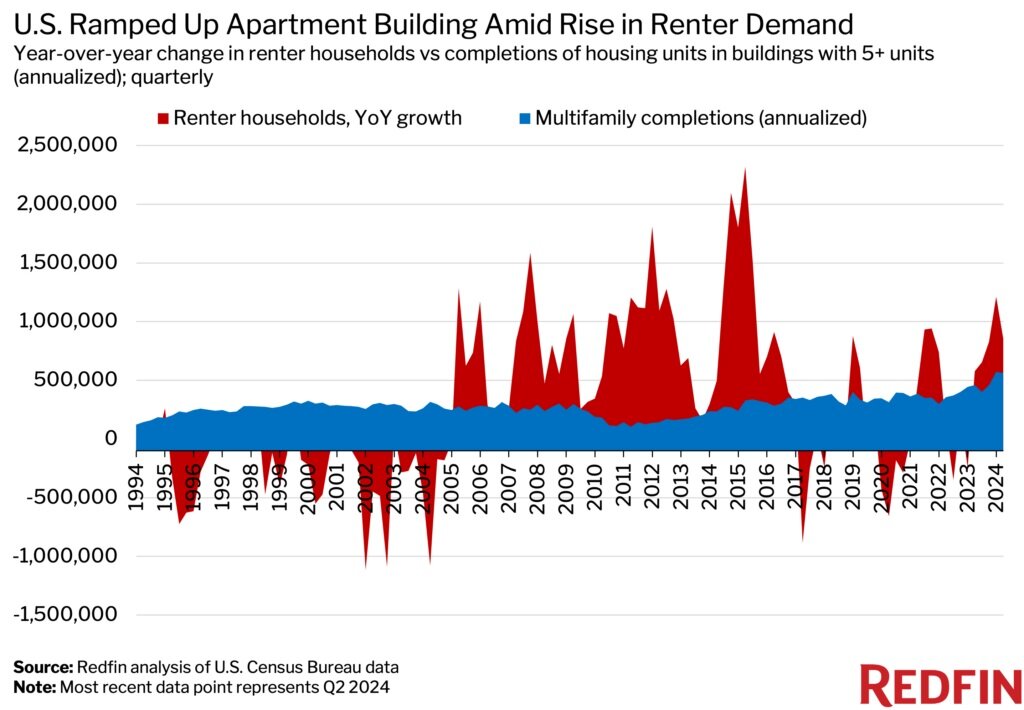Residential Real Estate News

Los Angeles, San Diego and New York Have Highest Concentrations of Renter Households
Residential News » Los Angeles Edition | By David Barley | August 9, 2024 7:20 AM ET
Renters in U.S. Grow Three Times Faster Than Homeowner Population
Based on new data from Redfin, the number of renter households in America grew 1.9% year over year in the second quarter to a record 45.2 million. That's over three times faster than the number of homeowner households, which grew 0.6% to a record 86.3 million.
The number of renter households grew at the second-fastest pace since 2021, while the number of homeowner households grew at the slowest pace since 2019.
Growth in the number of renter households hit a peak of 2.8% in the first quarter of 2024. That was the largest gain since 2015.
This is based on a Redfin analysis of U.S. Census Bureau data going back to 1994. A renter household is defined as one where the head of the household reports to the Census that they are renting out the property, while a homeowner household is one where the head of household reports they own the property. The number of homeowner and renter households are both at record highs because the U.S. population is at a record high.
Renter households have formed faster than homeowner households for three straight quarters, partly because home buying costs have risen much faster than rents.
The median apartment asking rent increased less than 1% year over year in June, while the median monthly mortgage payment jumped roughly 5%. Asking rents were 23% above pre-pandemic (June 2019) levels, while mortgage payments were 90% above pre-pandemic levels. Mortgage payments climbed because home prices hit a record high, and mortgage rates, while below their recent peak, were more than double the all-time low hit during the pandemic. While home buying costs did come down a bit in July, that has yet to bring buyers off of the sidelines.
"The cost of both renting and buying a home has skyrocketed in recent years, but the affordability crunch isn't quite as severe in the rental market. That's because America has been building a lot of apartments to keep pace with robust demand from renters," said Redfin Senior Economist Sheharyar Bokhari. "The country's leaders should heed this lesson when considering how to improve affordability in the home buying market: When there's more housing to go around, prices don't increase as fast."
It's important to note that while rents aren't growing as quickly as home buying costs, finding an affordable place to live is still a challenge for many renters. June's $1,654 median U.S. asking rent was the highest since October 2022 and only $46 below the all-time high. Nearly two in five renters don't think they'll ever own a home.
Renters may be able to find deals in Austin, TX and many parts of Florida, where rents are falling, but Florida faces intensifying risk from natural disasters and an insurance crisis.
America Has Been on a Multifamily Building Spree, But That Could Come to an End Soon
America has added a lot of renter households over the past year--855,000, to be exact. But it also has ramped up construction, which has helped accommodate that rise in demand and limit rent growth. The country is adding new multifamily housing units at an annual rate of 563,000 (as of the second quarter)--the second fastest pace in records dating back to 1994. The fastest pace was in the first quarter of 2024.
America still faces a housing shortage, but the recent boom in multifamily construction has helped narrow the gap. Multifamily building completions are at historic highs because many projects started during the pandemic housing frenzy are just now being finished. But it's worth noting that multifamily building permits and starts have slowed significantly, which could cause asking rents to jump again in the coming years.
Over Half of Households In Los Angeles Rent - the Highest Rate in the U.S.
Nationwide, just over one-third (34.4%) of households in the U.S. are renter households--a figure that has remained fairly steady over time. The share is much higher in coastal metros where it's expensive to buy a home.
Los Angeles has a rentership rate of 53%--the highest among the 75 largest U.S. metropolitan areas. It's followed by San Diego (52.4%) New York (50.1%), Fresno, CA (49%) and Austin, TX (46.3%). Fresno is the outlier in the group; it's not nearly as expensive as, say, Los Angeles or San Diego. But over 20% of residents in Fresno County live below the poverty line--nearly double the statewide share--making it challenging for many people to own a home.
Rentership rates are lower than average in parts of the country where it's more affordable to buy a home. In Worcester, MA, 23.2% of households are renter households--the lowest share among the metros Redfin analyzed. It's followed by North Port, FL (23.3%), Albany, NY (25.6%), Rochester, NY (25.7%) and Syracuse, NY (26.2%).
Sign Up Free | The WPJ Weekly Newsletter
Relevant real estate news.
Actionable market intelligence.
Right to your inbox every week.
Real Estate Listings Showcase
Related News Stories
Residential Real Estate Headlines
- Las Vegas Area Home Prices Uptick 4.3 Percent Annually in March
- Single-Family Rent Growth in U.S. Trends Upward in 2025
- U.S. Mortgage Rates Tick Down Post Trump Tariffs Commencement
- President Trump's 'Liberation Day' Tariffs Potential Impact on the U.S. Housing and Mortgage Markets
- Baby Boomers Biggest Cohort of U.S. Home Buyers in 2025 as Millennials Decline
- U.S. Monthly Housing Payments Hit Record High in 2025
- U.S. Pending Home Sales Uptick in February
- Global Prime Residential Rent Slowdown Continued in Late 2024
- Ireland Home Price Inflation Hits 8 Year High in Early 2025
- Existing Home Sales in America Uptick in February
- Great Miami Area Residential Sales Decline 15 Percent Annually in February
- Mortgage Rates Uptick in Mid-March, Ending 9-Week Decline in U.S.
- World Property Ventures Builds the Future of Real Estate with New Funding Round
- U.S. Builder Sentiment Declines Amid Economic Uncertainty and Rising Costs
- Black Homeownership Rates in U.S. Enjoy Largest Annual Increase of All Racial Groups
- Wealthy Renters Are Taking Over More of the U.S. Rental Market
- If U.S. Congress Does Not Extend NFIP Soon, Thousands of Daily Home Closings Impacted
- U.S. Mortgage Applications Spike 11 Percent in Early March
- Greater Palm Beach Area Residential Sales Rise in Early 2025
- New Apartments in U.S. Are Leasing at Slowest Pace on Record
- U.S. Mortgage Rates Drop to 4 Month Low in March
- Overall U.S. Mortgage Delinquency Rates Dip in December
- New Tariffs on Canada, Mexico to Impact U.S. Homebuilder Input Costs
- Monaco's Property Market: A Tale of Two Cities
- U.S. Home Purchase Cancellations Surge, 1 in 7 Sales Getting Canceled
- U.S. Pending Home Sales Hit Historic Low in Early 2025
- Greater Miami Area Residential Sales Dip in January
- Governor DeSantis Supports Ending Property Taxes in Florida
- WPV Aims to Become the Berkshire Hathaway of Real Estate Tech
- U.S. Home Sales Slump Continues in January
- Average Americans Spend 38 Percent of Monthly Income on Mortgage Payments
- Switzerland's Safe-Haven Appeal Grows with World's Wealthy Homebuyers
- U.S. Builder Confidence Rapidly Declines in February
- Las Vegas Home Sales Rise 6.7 Percent Annually in January, Condo Sales Dip
- Homebuyer Demand in America Drops to 5-Year Low in Early 2025
- Ownership More Affordable Than Renting in Most U.S. Markets
- The World's First Global Listings Service Launches, Called a GLS
- Home Prices Continue to Rise in 89 Percent of U.S. Metros in Late 2024
- Global Luxury Residential Prices Showed Gradual Improvement in Late 2024
- U.S. Construction Hiring Rate Drops to Lowest Levels in 5 Years







